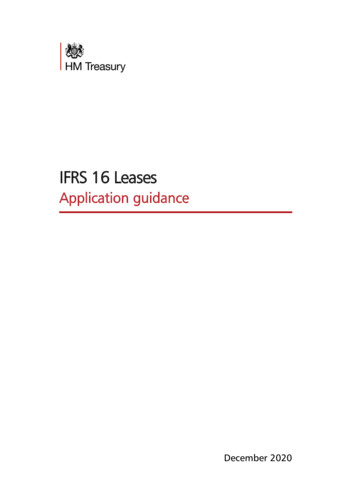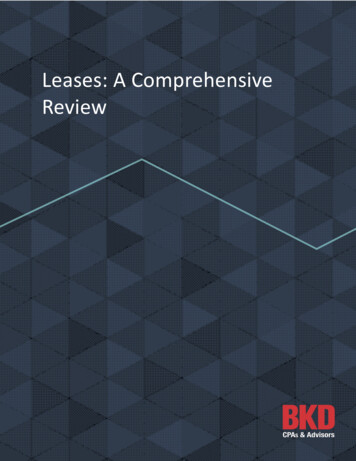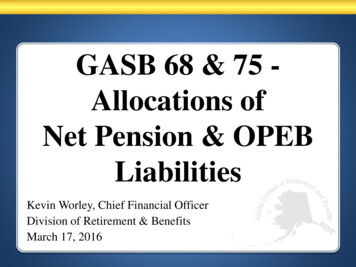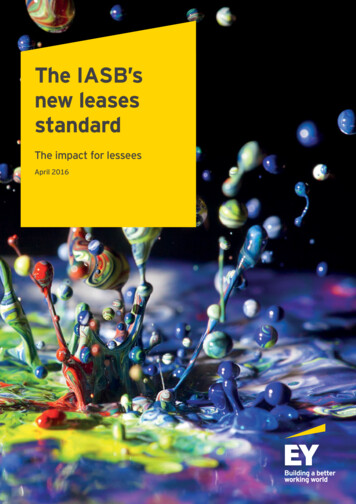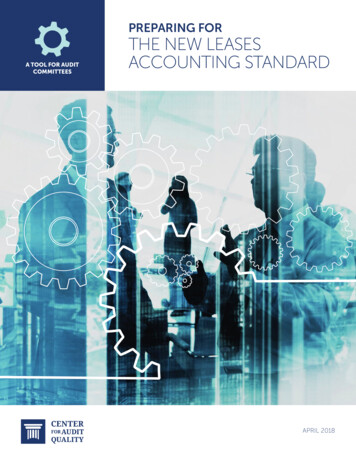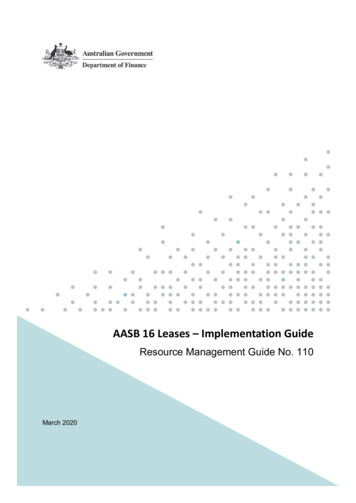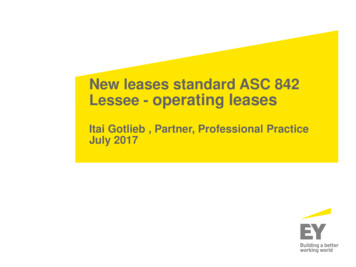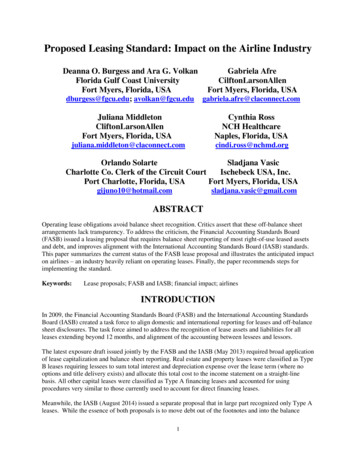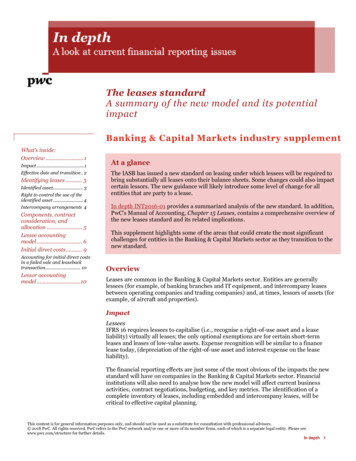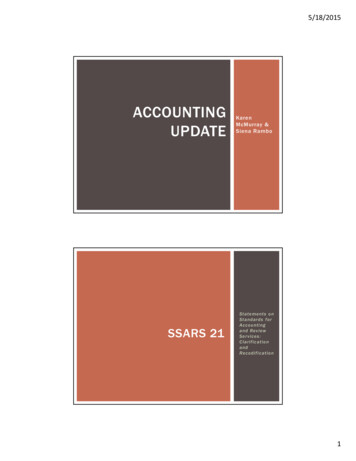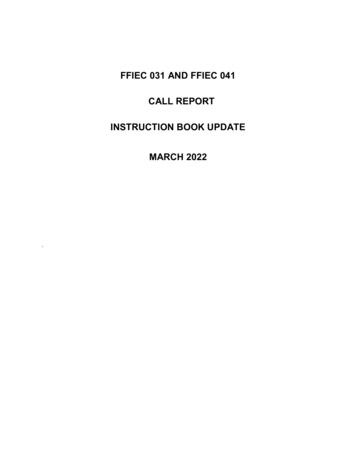
Transcription
GASB 87: LeasesGASB 87: LeasesWhat You Need to Know06/20221FORVIS is a trademark of FORVIS, LLP, registration of which is pending with the U.S. Patent and Trademark Office
GASB 87: LeasesTable of ContentsRecent Activity . 5Summary . 5Lease Definition . 6Control . 6Substitutions . 7Easements . 7Exchange or Exchange-Like Transaction . 7Bargain Leases . 7Materiality . 8Scope Exclusions . 8Intangible Assets . 8Subscription-Based Information Technology Arrangements . 8Oil & Gas Exploration & Production . 8Grazing & Hunting. 9Biological Assets . 9Cropland . 9Zoos . 9Inventory . 9Service Concessions. 9Conduit Debt . 9Supply Contracts . 10Other Exclusions . 10Contracts That Transfer Ownership . 10Lessor Scope Exceptions . 11Leases of Investment Assets . 11Certain Regulated Leases. 112
GASB 87: LeasesRegulated Lease Disclosures . 12Lease Term . 13Reasonably Certain . 14Fiscal Funding Clauses. 14Reassessment . 15Short-Term Leases . 15Multiple Lease Components . 16Multiple Concurrent Contracts . 17Discount Rate (Lessee & Lessor) . 18Lessee Accounting . 20Initial Measurement . 20Lease Liability . 20Lease Term for Measuring the Lease Liability . 20Variable Payments . 21Purchase Options & RVGs. 21Lease Incentives . 22Lease Asset . 23Subsequent Years’ Recognition & Measurement . 24Remeasurement . 25Impairment . 26Lessor Accounting . 26Leveraged Leases . 26Initial Measurement . 27Lease Receivable . 27Variable Payments . 27RVG . 28Deferred Inflow of Resources. 28Lease Incentives . 283
GASB 87: LeasesLeasehold Improvements . 29Subsequent Years’ Recognition & Measurement . 29Lease Revenue/Deferred Inflow. 29Interest Revenue/Lease Receivable . 30Underlying Asset . 30Remeasurement . 30Discount Rate . 30Disclosures . 31Lessee . 31Lessor . 31Lease Modifications & Terminations . 32Lease Modification Accounting . 33Modifications Resulting from a Lessor's Debt Refunding . 34Partial & Full Lease Termination Accounting . 34Sale-Leaseback Transactions . 35Regulated Operations . 35Lease-Leaseback Transactions . 36Subleases . 37Intra-Entity Leases. 37Related-Party Leases . 37Transition . 38Conclusion . 39Contributors . 39Appendix . 404
GASB 87: LeasesRecent ActivitySince GASB issued Statement 87, Leases, in June 2017, there have been several updates and one effective datedelay. This document has been refreshed to incorporate subsequent standard setting and implementation guidanceissued by GASB 1.The guidance is now effective for fiscal years beginning after June 15, 2021, and subsequent reporting periods.Effective DateStatement 87, Leases(as amended)Fiscal years beginningafterJune 15, 2021SummaryUnder current guidance, operating leases are reported without liability recognition even though the governmentoften is committed to make payments on a long-term basis; the lessor records no receivable for its long-term rightto receive payments. GASB Statement 87, Leases, establishes a uniform approach to accounting for and reportingleases based on the principle that all leases are—in substance—financings. Lease accounting is no longer basedon the arrangement’s classification as either capital or operating lease.The new lease treatment will be similar to current guidance for capital leases. A lessee government will recognize alease liability and intangible right-to-use (RTU) lease asset at the lease term’s beginning. Rent expense undertoday’s operating leases will be replaced with interest and amortization expenses. A lessee will recognize intereston the lease liability and amortization on the intangible lease asset over the lease term or—if shorter—theunderlying asset’s useful life. Because lease transactions under Statement 87 are considered a financingarrangement, lessees will present the intangible RTU lease asset as a capital asset and a lease liability for thefuture payments.A lessor government is required to recognize a lease receivable and a deferred inflow of resources at the leaseterm’s beginning. Lease revenue will be systematically recognized over the lease term with a correspondingreduction in deferred inflow of resources. Interest income on the lease receivable created by the financingarrangement will be recognized using the effective interest method. Lessors will not derecognize the underlyingasset or calculate a residual value.Lessees and lessors must disaggregate nonlease (service components) and contracts with multiple leasecomponents. Regular reassessments of amounts recorded by the lessee and lessor as lease liabilities and leasereceivables, respectively, are required under certain circumstances.For lessees, the current operating lease category will be eliminated, along with potential opportunities to structure alease for the desired financial statement effect. All leases will result in the recognition of interest and amortizationexpense, and all lease commitments will be recognized as liabilities unless one of the exceptions is met. In thecash flows statement, lease payments will be classified as financing outflows.For lessors, derecognition of the underlying asset and calculation of the residual value are not required, and directfinancing and sales-type lease categories are eliminated under Statement 87.Both lessees and lessors must provide enhanced disclosures.For help getting started, see “Implementing GASB’s Lease Guidance.”This includes GASB Statement 93, Replacement of Interbank Offered Rates; GASB Statement 92, Omnibus 2020; GASBStatement 95, Postponement of the Effective Date of Certain Authoritative Guidance; GASB Statement 99, Omnibus 2022;Implementation Guide 2019-3, Leases; and Implementation Guides 2020-1 and 2021-1.15
GASB 87: LeasesLease DefinitionControlTimePeriodExchange“A contract that conveys control of the right to use another entity’s nonfinancial asset(the underlying asset) as specified in the contract for a period of time in an exchange orexchange-like transaction.” – GASB 87A nonfinancial asset is an asset not meeting the definition of a financial asset as defined in Statement 72, FairValue Measurement and Application. Examples of nonfinancial underlying assets are buildings, land, vehicles, andequipment. In the updated definition, the term “contract” replaces “agreement” to require that a lease—whetherwritten or verbal—be legally enforceable.Contracts for services are not leases. Contracts conveying the right to use an underlying asset that includes aservice component are discussed below in the Multiple Lease Components section.A contract should be evaluated for accounting as a lease based on the substance or the arrangement rather thanthe label on the contract. For example, a contract that transfers ownership of the underlying asset is a purchaseregardless of whether it is labeled as a lease.ControlThe notion of control in the lease definition is applied to the contract’s specified RTU asset. A lessee has obtainedcontrol of the right to use the asset if the contract conveys to the lessee both the right to determine the underlyingasset’s nature and manner of use and obtain the underlying asset’s present service capacity. Unlike currentguidance, the new criteria do not limit a lease to contracts that convey “substantially all” of the present servicecapacity from the underlying asset’s use.GASB Implementation Guide 2020-1 included the following example to illustrate the control concept:A city enters into an agreement that allows an organization to use one floor of a city building at a market rate.The contract states that the space is to be used only for a restaurant. Does the organization have control of theright to determine the nature and manner of use of the space?The organization has control of the right to determine the nature and manner of use of the space within theparameters of the contract (for a restaurant); therefore, the control criterion is met.6
GASB 87: LeasesGASB Implementation Guide 2021-1 included the following example to illustrate the control concept:A city owns a fleet of equipment. The pieces of equipment are capital assets reported in an internal service fund.The internal service fund is used to report fleet management activity that provides other departments of the city(within the same legal entity) with the right to use the equipment on a cost-reimbursement basis. In the city’s basicfinancial statements, should the agreements between the city’s departments be reported as leases?No. In this circumstance, control is not conveyed to another legal entity; therefore, the agreements should not bereported as leases in the city’s basic financial statements.Examples – ControlAre cell phone tower or antenna placement agreements leases?Yes, if the agreement meets the lease definition and the control criterion. The control criterion generally is met if acell phone tower or antenna placement agreement conveys control of the rights to use the land on which the toweris placed or the connection point to which the antenna is affixed.A government enters into a multiyear agreement for the right to use a facility. The government has exclusive useof the facility three days a week. Other parties use the facility on the other days. To meet the lease definition, isthe government required to have uninterrupted control of the right to use the facility?No. In determining whether a contract conveys control of the right to use an underlying asset, a governmentshould assess whether it has (a) the right to obtain the present service capacity from use of the underlying assetand (b) the right to determine the nature and manner of use of the underlying asset as specified in the contract. Ifthe contract specifies the government has control of those rights during three days of each week, the controlcriterion is met. The requirement that the contract be for a period of time does not require uninterrupted usage.SubstitutionsA lease conveys control of the right to use another entity’s asset, which is distinct from the underlying asset. TheRTU asset relates to the service capacity associated with an underlying asset, rather than the underlying assetitself. Substitution with an essentially identical asset allows the lessee to maintain control of the right to use theservice capacity of another entity’s underlying asset and does not violate the definition of a lease.EasementsAn easement is a lease only if it meets the definition of a lease that includes a period-of-time criterion. Theimplementation guide notes that permanent easements do not meet the period-of-time criterion. In addition,easements obtained for a nominal amount would not meet the exchange or exchange-like criterion.Exchange or Exchange-Like TransactionImplementation Guide 2021-1 clarifies that the assessment of whether the exchange or exchange-like transactioncriteria is met should consider all values exchanged, including expected variable payments.Bargain LeasesThe lease definition only applies to exchange or exchange-like transactions and would exclude contracts withnominal lease payments. A government’s right to use land for 1 per year, which has a market rent of 100,000 peryear, does not meet the description of an exchange or exchange-like transaction because each party does notreceive or give up essentially equal value or not quite equal value. This type of arrangement represents anonexchange transaction, e.g., a donation or grant, which is within the scope of Statement 33, Accounting andFinancial Reporting for Nonexchange Transactions, and is not within Statement 87’s scope.7
GASB 87: LeasesMaterialityStatement 87 does not include a quantitative threshold exception for lower-value leases. Under GASB’s generalmateriality guidelines, if the underlying assets are insignificant—individually and in the aggregate—this statement’sprovisions may not apply. However, entities establishing a lease capitalization policy similar to that of capital assetsare cautioned because the significance of asset capitalization is independent of the assessment of the significanceof liability recognition.Scope ExclusionsStatement 87 carries forward several explicit scope exceptions from Statement 62, including contracts for rights toexplore for natural resources, licensing contracts, and service concession arrangements, and expands the numberof exclusions. Because leases will be reported on the statement of financial position, the implementation guideaddresses several concerns raised by governments. GASB declined to provide an exception for assets underconstruction, historical works, and leases associated with certificates of participation.Specific Scope ExclusionsIntangible assetsBiological assetsInventoryService concessionsConduit debt financingsSupply contractsIntangible AssetsThis exclusion applies to the right to explore for or exploit natural resources (such as gas, mineral, and othernonregenerative resources), licensing contracts (such as motion pictures, videos, patents, and copyrights) andcomputer software.Subscription-Based Information Technology ArrangementsGASB Implementation Guide No. 2015-1 stated that licensing agreements for computer software should not betreated as leases. Because of the unique features and complexities of these transactions, GASB decided toexplicitly exclude licensing contracts for computer software from Statement 87 (see “New GASB Rules for CloudComputing Costs”).Oil & Gas Exploration & ProductionExampleA government enters into a lease agreement that conveys control of the right to use a parcel of land to acompany that engages in oil and gas exploration and production. Is this lease excluded from Statement 87?No. In this example, the company has control of the right to use the land itself. In contrast, if the government onlyprovided the company with the right to explore for or exploit oil and gas but did not convey control of the right touse the land, that lease would be excluded from Statement 87. Although Statement 87 excludes “rights toexplore for or to exploit natural resources such as oil, gas, and minerals,” that exclusion applies only when theunderlying asset in the lease is the right to explore for or exploit those resources.8
GASB 87: LeasesGrazing & HuntingA government agreement that provides the exclusive right to use the government’s land for five years duringhunting season would be considered a lease. Because the lessee is the only party allowed to access and use theland during the hunting season each year during the term of the five-year agreement, the contract conveys controlof the right to use the underlying asset (the land). The provision in the lease definition that the contract be for aperiod of time does not require uninterrupted control of the right to use the underlying asset.Facts and circumstances are critical in determining if an agreement meets the lease definition. Consider anagreement that allows a rancher to use the government land for grazing and also allows access for compatiblepublic recreation activities. The agreement further states that the government can construct roads and buildings, orotherwise alter the land, without the rancher’s permission. This agreement would not be considered a lease since itdoes not convey the right to determine the nature and manner of use of the underlying asset because the ranchercannot prevent others from accessing, using, or altering the land.Biological AssetsThis exclusion applies to timber, living plants, and living animals.CroplandWhile the use of land for farming may produce biological assets, the lease’s underlying asset is the land, which isnot a biological asset. A lease of cropland would not be excluded from Statement 87’s scope.ZoosA city-owned zoo that leases various animals (biological assets) for a specific period of time would be excludedfrom Statement 87’s scope.InventoryBecause the lease of inventory normally involves a transfer of ownership rather than a lease, it is specificallyexcluded from Statement 87’s scope.Service ConcessionsAccounting guidance for service concessions is currently covered by Statement 60 (see “GASB Updates PublicPrivate Partnership Accounting” for changes to the guidance with the issuance of Statement No. 94, Public-Privateand Public-Public Partnerships and Availability Payment Arrangements).Conduit DebtLeases in which the underlying asset is financed with outstanding conduit debt are excluded from Statement 87’sscope, unless the lessor reports both the underlying asset and conduit debt. 2 In June 2019, GASB issuedStatement 91, Conduit Debt Obligations, which updates guidance for the accounting and reporting of conduit debt(see “GASB Issues New Conduit Debt Rules”).For purposes of Statement 87, conduit debt is debt issued in the government’s name to finance the construction or acquisitionof capital assets to be leased, which is secured by the lease payments. Issuers of conduit debt are not required under Interpretation No. 2,Disclosure of Conduit Debt Obligations, to recognize a liability for the debt. Likewise, the facilities constructed or acquired with the debtproceeds generally are not reported in the financial statements of issuers of conduit debt.29
GASB 87: LeasesSupply ContractsSupply contracts, such as power purchase agreements, are intended to result in the purchase or sale of acommodity, such as natural gas or electricity, used in the normal course of operations. Such agreements normallydo not convey the right to use the underlying asset but rather convey a right to the output generated by theunderlying asset; therefore, they do not meet the lease definition. However, if a contract conveys control of the rightto use the underlying asset for a period of time in addition to the right to the output generated by the underlyingasset, the scope exception does not apply.Example – A government enters into a contract with a private party wherein the private party will design andbuild a solar farm based on the government’s specifications. The solar farm will be located on the government’sproperty, but title to the solar equipment will be retained by the private party. The contract requires thegovernment to purchase all the power generated from the solar farm and make payments solely based on theamount of power generated. The contract also requires the private party to dismantle and remove the solar farmat the contract’s end. Does this contract result in a lease of solar equipment?No. To meet the lease definition, a contract is required to convey control of the right to use the underlying asset.Two criteria must be met for a contract to convey control. In this example, the government has the right to obtainthe present service capacity from the solar farm but does not have the right to determine the nature and mannerof use. Therefore, the component of the contract that provides the government with the right to all the powergenerated by the solar farm does not convey control and does not meet the lease definition. However, thecompone
GASB 87: Leases. 6 . Lease Definition "A contract that conveys control of the right to use another entity's nonfinancial asset (the underlying asset) as specified in the contract for a period of time in an exchange or
